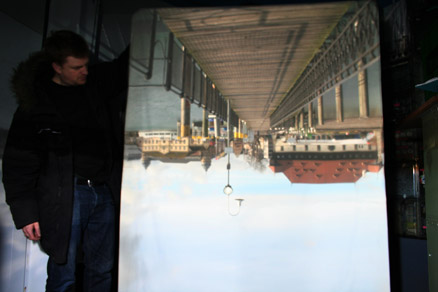|
| |
'Konstanz, 19 January 2008' and 'Bodensee, 20 January, 2008' were made in 2008 in the Southern German city Constance. With the use of cardboard, blackout cloth and a simple lens the small building at the entry to the port was transformed into a camera obscura. The building has multiple uses: it is used by the government in order to measure the depth and temperature of Lake Constance (Bodensee) as well as serving as the base to the huge 10 meter high, 18 tonne revolving sculpture of Imperia (created by Peter Lenk and erected in 1993). It is also the lookout spot for the thousands of tourists who come to admire the view across the lake towards the mountains in Switzerland and Austria. In pitch darkness sheets of colour photographic paper were pinned up opposite either window of the building and exposed through the small aperture to create a negative photograph. These pictures were subsequently used to create photographic positives. |
|
| |
|
|
| |
 |
|
| |
'Bodensee, 20 January, 2008' Unique colour c-type photograph, 162.4 x 152.5cm |
|
| |
|
|
| |
 |
|
| |
'Bodensee, 20 January, 2008' positive colour c-type photograph, 162.4 x 152.5cm |
|
| |
|
|
| |
 |
|
| |
'Konstanz, 19 January, 2008' Unique colour c-type photograph, 162.4 x 152.5cm |
|
| |
|
|
| |
 |
|
| |
'Konstanz, 19 January, 2008' positive colour c-type photograph, 162.4 x 152.5cm |
|
| |
|
|
| |
 |
|
| |
'Imperia' Konstanz |
|
| |
|
|
| |
 |
|
| |
Interior view during project construction |
|
| |
|
|
| |
 |
|
| |
Installation view: Axel Lapp Projects, Berlin, 2008 |
|
| |
|
|
| |
"Newth depicts what is there, he presents a contemporary view on a city that has evolved since the Middle Ages and on the timeless expanse of the lake that has changed little over time. His photographs, which were created with minimal technical effort, and which refer back to the time when photography was invented, are at the same time documents of our present and deserted images of the historical environment. For the first time with this series, Martin Newth was working with photographic colour paper. The different colours of natural and studio light are the reason for the chromatic distortions, which resemble early colour photographs, in which the red and yellow parts of the image have already faded."1 |
|
| |
1: from press release for 'Ausblick', Axel Lapp Projects, Berlin, by Axel Lapp |
|
| |
|
|
| |
The images were originally made for an exhibiton 'Menschen und Orte' which celebrated the 150 year anniversary of Kunstverein Konstanz and went on to be exhibited in a solo exhibition, 'Ausblick' at Axel Lapp Projects, Berlin. |
|
| |
|
|
| |
|
|
| |
|
|
| |
Top of page |
|
| |
|
|
| |
|
|
| |
|
|
|






